Undertaking historical research work into early pupils of the School is like unravelling the best detective story!

Researching the names of pupils embroidered on a sampler listing pupils in 1838, E Zurhorst (marked) turned out to be Eliza Clarissa Zurhorst. As she was not listed at the School in the 1841 census, it meant that she had left school by then which gave her a birth date of around 1823. The name was unusual enough to be fairly sure that the Eliza who was baptised at Hackney St John in August of that year was the right one. The parents were Frederick William and Ann Judith Zurhorst.
The early registers[1] of the School then revealed another Zurhorst, this time Rosina Matilda born in 1815. The register confirmed the names of both parents so even if the baptismal record for Eliza had any doubt attached, the school register clarified the connection.

It was unusual for two sisters to attend the School. Indeed the rules had been very clear that only one daughter was to be granted a place. Furthermore, both parents were alive throughout the time their daughters were pupils and for some time afterwards. There was no rule that the father must be deceased before a girl could be admitted to the School but there was a clear rule about indigence so, if Frederick was still alive during and after his daughters being at the School, his indigence must be in terms of income or family circumstances. As the layers of the Zurhorst story began to peel away, it revealed another connection with the School that was rather unexpected.
Eliza and Rosina were two of the 18 children of Frederick and Judith. Yes, you did read that correctly. Eighteen!
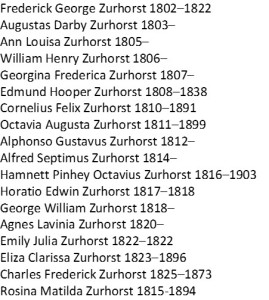
It is not known where the Zurhorst name originated. Frederick William was born in Ireland and his father Hermann had arrived there from Rotterdam but it is not known if he was actually Dutch. It would appear, however, that Frederick William spent the majority of his life in Britain. He married Ann Judith Williams on 12 Oct 1801 at St Botolphs, Aldgate where he gave his residence as Portsoken. This is an area of London next to the parishes of Spitalfields, Stepney, and St. George’s in the east, its name suggesting that it was originally a trading post by the gates to the City. Ann Judith lived in Spitalfields. That the Zurhorsts continued to live in this area is shown by the baptismal place for their many offspring and also that Frederick William was granted the freedom of the City in 1815.
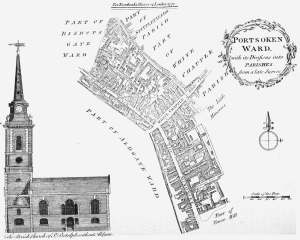
Image of Portsoken Ward from http://www.british-history.ac.uk/no-series/new-history-london/pp663-665[2]
He was a member of the Lodge of Peace and Harmony as was the father of Patience Smith (previous posting, which also featured St Botolphs). His trade was given variously as a shipping agent or a broker. He is listed in London trade directories of the time which might suggest a growing prosperity. More unusually, Ann Judith was also in business as she traded in ready-made linen. This might suggest an entrepreneurial couple but for that rule at the School about indigence which gives a different slant. Of course, it is possible that simply because of their very large number of siblings the girls, Eliza and Rosina, became eligible for Masonic support.
Other documents indicated that Fredrick was in business with his wife. The evidence suggested that the pair probably ran a linen warehouse on the banks of the Thames.[3]
The ‘other documents’ are not identified in the article. This might suggest an entrepreneurial couple but for that rule at the School about indigence which gives a different slant. Perhaps Frederick William became involved in the linen warehouse because his ship brokering business was not bringing in the income it once had. Of course, it is possible that simply because of their very large number of siblings the girls, Eliza and Rosina, became eligible for Masonic support.
The reference to the programme Who Do You Think You Are, and specifically to the Sheila Hancock episode is the first half of the curious connection but let us look at the stories of Eliza and Rosina first.
Eliza was born in the year that Rosina entered the School – 1823. Baptised at St John’s, Hackney, she will have come to the School probably after her older sister had left it although it is just possible that they were both there for a brief time together.
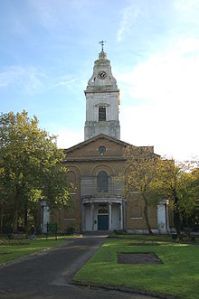
St John’s Hackney image from Wikipedia attributed to K B Thompson
Of her time at the School there is no information but she left between 1838 and 1841 and the first reference to her after school is with her parents in St Peter Port, Guernsey in 1841. No address is cited in 1841 but in 1851, by which time Ann Judith had died, it was given as 4 Mount Row, St Peter Port.

The aerial view above is courtesy of Google Earth and the image of a house in Mount Row is from an online property sale. It is probably not No 4 but gives an idea of perhaps the sort of house they occupied.
Thereafter Eliza disappears from the records until we find her death in 1896 in West Ham. The probate adds a curious note as it lists her as ‘Zurhorst otherwise Harris’ but records her as a spinster of 69 Chichester Rd, Leytonstone who died on 2nd November 1896. It is unclear from this why she should have the two surnames but there is a fleeting glimpse of an Eliza C Harris of the right age as a visitor to a house in Jamaica Street, Mile End Old Town. The probate was granted to Lemprière Hughes Renouf, civil servant. [Nope – no idea!] The name may suggest a continuing association with the Channel Islands and you probably won’t be surprised to hear that, much later and entirely unconnected, there is another Renouf association with the School!
Rosina, on the other hand, perhaps because she stayed on the mainland, is more easily traced.
She had joined the School in 1823 when the family residence was Down Terrace, Hackney.
Smaller houses called Down Terrace, some occupied by tradespeople, lined part of Back Lane (later Clarence Road) by 1821.[4]
A report in 2013[5] gave the information that this terrace, renamed Amhurst Terrace, was having to be demolished as cracks in the building had been reported by members of the public.
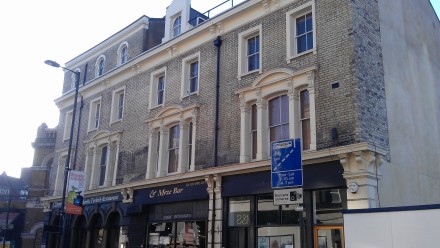
Image from http://www.hackneyhive.co.uk/index/2013/11/amhurst-road-view-images-of-visible-damage-to-gibbons-building/ courtesy of Nick Perry.
Rosina left School on 23rd September 1830, ‘delivered to her mother’ at 13 Retreat Place, Homerton. Although Retreat Place still exists, it comprises C20th blocks of flats today. In 1830 it was an area which, once respectable, was beginning to slide downhill in terms of gentrification.
Rosina married John Butter Petrie, a dock clerk at the West India docks, on 31 Oct 1837 at St Mary Stratford Bow and between 1839, when their firstborn arrived, and 1878, when John died, they lived in the Bethnal Green/Hackney/St George in the East/Poplar district at various addresses. In 1881 the widowed Rosina was living with one married daughter (Jane, who married Alfred Zurhorst, her cousin and son of Hamnet – see 5 paragraphs further on!) and another married daughter (Clementine) was also there with her son. The names of the daughters were all from John’s side of the family. His mother had been Helen Butter before she married and Helen Ann Petrie (the firstborn) in 1851 is living at the home of Clementine Anderson, her aunt. Jane Zurhorst nee Petrie, also called her own daughter Clementine as did older sister Helen who had married Harry G Montiguani in Scotland. (And you thought quadratic equations were difficult!)
After John’s death, Rosina found life more challenging and in 1889 was admitted to Bromley House, part of the Workhouse, described as ‘destitute, widow of John; admitted from Poplar’. In 1891 she is listed as a patient in Poplar and Stepney Sick Asylum, the buildings of which were finally demolished in 2008. [For more information about the Workhouse see http://www.workhouses.org.uk/PoplarAndStepneySAD/. This fabulous website is the work of Peter Higginbotham on the workhouses of Britain and contains a wealth of information.]
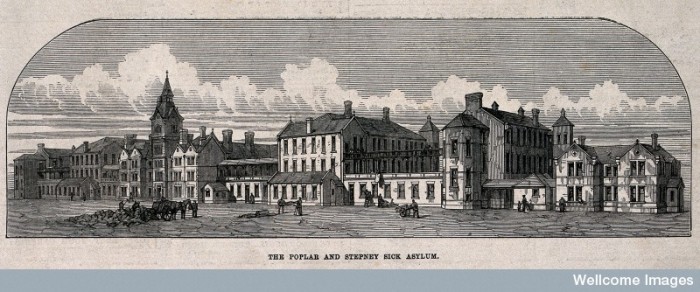
Credit: Wellcome Library, London. Wellcome Images
images@wellcome.ac.uk
http://wellcomeimages.org
The Poplar and Stepney Sick Asylum, Bromley-by-Bow: the street facade. Wood engraving, (c.1870?).
1870 after: Arthur Harston and Christopher HarstonPublished: –
Copyrighted work available under Creative Commons Attribution only licence CC BY 4.0 http://creativecommons.org/licenses/by/4.0/
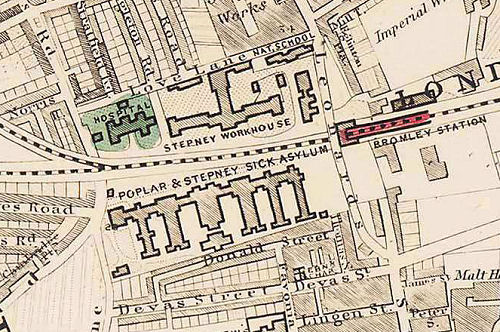
It seems very likely that a death record of 1894 is that of Rose Matilda although the second forename is given as Martha. No further records for her are traced after this date. There is no probate but that is hardly surprising if she were destitute.
So the story of two Zurhorst daughters is encompassed by the nineteenth century and might have stayed there but for the BBC programme Who Do You Think You Are. The episode featuring the Zurhorsts was that for Sheila Hancock who had in her possession a portrait known as Madam Zurhorst.
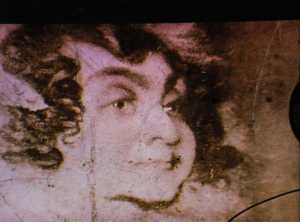
The story outline of Sheila’s ancestry can be read on http://www.bbc.co.uk/whodoyouthinkyouare/past-stories/sheila-hancock.shtml or http://www.whodoyouthinkyouaremagazine.com/episode/sheila-hancock which establishes her as great-great grandniece of Eliza and Rosina – her direct ancestor was the girls’ brother Hamnet whose son Rosina’s daughter married. So Sheila Hancock connects to the School through her ancestors – but also, because she was married to John Thaw, there is a further curious connection.
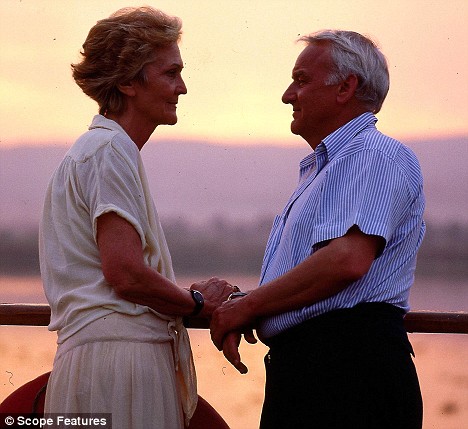
Image from http://www.dailymail.co.uk/femail/article-1053307
In 1991, John Thaw was at the School filming an episode of Inspector Morse, during which time two other pupils, Shezel and Mandy, interviewed him for the School magazine, which means that four pupils are involved in this story!
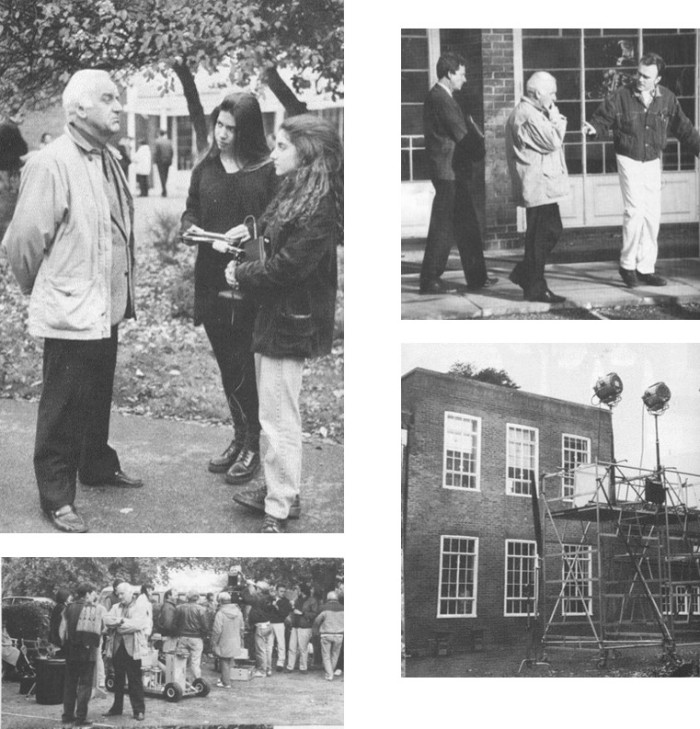
Images from School magazine Machio
So from Rotterdam, via Ireland, London, the Channel Islands and Scotland and finally to Hertfordshire, the story of the Zurhorsts, Eliza and Rosina in particular, has some very curious connections between the nineteenth and twentieth century worlds and the School!
[1] GBR 1991 RMIG 3/2/1 Library & Museum of Freemasonry
[2] John Noorthouck, ‘Book 2, Ch. 25: Portsoken Ward’, in A New History of London Including Westminster and Southwark (London, 1773), pp. 663-665. British History Online http://www.british-history.ac.uk/no-series/new-history-london/pp663-665 [accessed 13 January 2017].
[3] http://www.bbc.co.uk/whodoyouthinkyouare/past-stories/sheila-hancock.shtml
[4] ‘Hackney: Clapton’, in A History of the County of Middlesex: Volume 10, Hackney, ed. T F T Baker (London, 1995), pp. 44-51. British History Online http://www.british-history.ac.uk/vch/middx/vol10/pp44-51 [accessed 17 January 2017].